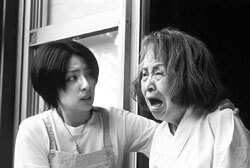Japanese movie garners shrieks absent from “Blair Witch”
When a film stops making sense, it can get scary from that as much as from its thrills.
“Ju-On: The Grudge” bases its terror around the feeling of being lost in an incomprehensible narrative. Its characters are plunged into a haunted house of shadows, curses, and homicidal ghosts and take the audience along. The film’s narrative structure wouldn’t be unusual for an art film, but it’s pretty unique for a horror film. (Hideo Nakata’s 1999 thriller “Chaos” is the most recent Japanese counterpart.)
Divided into six parts, each named after a different character, the film requires us to follow it without the usual comforts of conventional storytelling––characters with whom one can easily identify and narrative closure. The nominal protagonist appears in only three parts, and the spectator has to wait half an hour before finding out what happened to her after the first part. The fifth section, named for the teenage girl Izumi, runs about five minutes before we learn her connection to the house.
This version of “Ju-On: The Grudge” is a remake, a successor to two straight-to-video productions with the same premise and name. The videos weren’t too popular at first, but they eventually found enough of a cult audience to warrant a theatrical version. “Ju-On: The Grudge 2” was released in Japan earlier this year. Slicker and even grimmer, it revolves around a TV shoot in the haunted house. Unfortunately, it indulges ill-advised concepts like a haunted copy machine and an attack by a crawling wig. Coming this fall will be Shimizu’s Americanized remake, produced by Sam Raimi and starring Sarah Michelle Gellar but set in the same house. Even if the same director is behind the controls, it’s hard to picture a Hollywood genre film with the same audacity.
In the first part of “Ju-On: The Grudge,” Rika (Megumi Okina) volunteers at a welfare office. She’s handed the case file left over when a colleague went missing. Going to her clients’ house, Rika opens the door and sees shoes scattered all over the living room. After she hears clanking, she discovers a near-catatonic elderly woman behind a door. She then hears rustling in a closet. Thinking that it’s just a cat, she opens the door and sees a little boy. The elderly woman rises slightly from her passive state to repeatedly mutter, “I told her again and again” as she rocks back and forth. A specter attacks the elderly woman, and then turns her attentions to Rika, who passes out, as the boy watches. Then the second section, which actually precedes it chronologically, begins.
Many recent Japanese horror films show a fear of technology, perhaps derived from the enormous shadow of Hideo Nakata’s “Ring.” (Its screenwriter served as a “creative consultant” on “Ju-On: The Grudge,” along with Kiyoshi Kurosawa). Shimizu addresses some of these concerns in its third and weakest section, “Hitomi.” A mixed bag, it includes some striking images, but relies on a character nonsensically lying in bed waiting for ghosts to come after her. A guard literally turns to dust on a security camera video. We later see more of it, culminating in an image of all-consuming darkness, save for a pair of menacing eyes. Hitomi turns on the TV to relax, but an innocuous report about birds gets distorted into a still reminiscent of Edvard Munch’s “The Scream.” The ghosts are able to impersonate her brother-in-law on the phone and at her door.
There’s no on-screen violence in “Ju-On: The Grudge”––unless the guard’s disappearance counts––but Shimizu’s visual restraint goes well beyond merely avoiding gore. He never uses an image if a sound would do. He delays the appearance of ghosts as long as possible, signaling ominous events with noise. His tracking shots suggest someone craning their neck, struggling to see something just out of their sightline. The simple task of opening a door cranks up tension. Although sometimes heavy-handed, the score effectively layers orchestral and electronic drones to create an atmosphere of terror.
While “Ju-On: The Grudge” seems to draw on several Nakata films, it reminds me more of “The Blair Witch Project,” both in its use of off-screen space and its vision of youthful optimism––encompassing female independence and faith in technology––confronting the supernatural and failing miserably. Here, the young are put on the chopping block, sacrificed to “pay” for a distant murder. As much as “The Exorcist,” the film pivots around fear of children. In fact, “Ju-On: The Grudge 2 “ takes this theme even further. Family ties are deadly, since the haunting spreads like the flu.
Hitomi “catches” it from her brother-in-law, whom she visits in the second part. Some of the film’s final images recall the glacial chill of the coda to Michelangelo Antonioni’s “L’eclisse”––a world stripped of humanity and reduced to a collection of objects and uninhabited places. A grim worldview, it’s one that “Ju-On: The Grudge” puts across with tremendous skill.


































